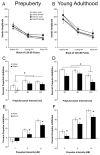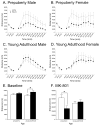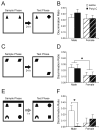Altered object-in-place recognition memory, prepulse inhibition, and locomotor activity in the offspring of rats exposed to a viral mimetic during pregnancy
- PMID: 22119062
- PMCID: PMC4464820
- DOI: 10.1016/j.neuroscience.2011.11.011
Altered object-in-place recognition memory, prepulse inhibition, and locomotor activity in the offspring of rats exposed to a viral mimetic during pregnancy
Abstract
Infection during pregnancy (i.e., prenatal infection) increases the risk of psychiatric illnesses such as schizophrenia and autism in the adult offspring. The present experiments examined the effects of prenatal immune challenge on behavior in three paradigms relevant to these disorders: prepulse inhibition (PPI) of the acoustic startle response, locomotor responses to an unfamiliar environment and the N-methyl-d-aspartate antagonist MK-801, and three forms of recognition memory. Pregnant Long-Evans rats were exposed to the viral mimetic polyinosinic-polycytidylic acid (PolyI:C; 4 mg/kg, i.v.) on gestational day 15. Offspring were tested for PPI and locomotor activity before puberty (postnatal days (PNDs)35 and 36) and during young adulthood (PNDs 56 and 57). Four prepulse-pulse intervals (30, 50, 80, and 140 ms) were employed in the PPI test. Recognition memory testing was performed using three different spontaneous novelty recognition tests (object, object location, and object-in-place recognition) after PND 60. Regardless of sex, offspring of PolyI:C-treated dams showed disrupted PPI at 50-, 80-, and 140-ms prepulse-pulse intervals. In the prepubescent rats, we observed prepulse facilitation for the 30-ms prepulse-pulse interval trials that was selectively retained in the adult PolyI:C-treated offspring. Locomotor responses to MK-801 were significantly reduced before puberty, whereas responses to an unfamiliar environment were increased in young adulthood. Both male and female PolyI:C-treated offspring showed intact object and object location recognition memory, whereas male PolyI:C-treated offspring displayed significantly impaired object-in-place recognition memory. Females were unable to perform the object-in-place test. The present results demonstrate that prenatal immune challenge during mid/late gestation disrupts PPI and locomotor behavior. In addition, the selective impairment of object-in-place recognition memory suggests tasks that depend on prefrontal cortex may be particularly vulnerable following prenatal immune challenge.
Copyright © 2011 IBRO. Published by Elsevier Ltd. All rights reserved.
Figures





Similar articles
-
Maternal Immune Activation during Pregnancy Alters the Behavior Profile of Female Offspring of Sprague Dawley Rats.eNeuro. 2019 Apr 19;6(2):ENEURO.0437-18.2019. doi: 10.1523/ENEURO.0437-18.2019. eCollection 2019 Mar-Apr. eNeuro. 2019. PMID: 31016229 Free PMC article.
-
Behavioral alterations in rat offspring following maternal immune activation and ELR-CXC chemokine receptor antagonism during pregnancy: implications for neurodevelopmental psychiatric disorders.Prog Neuropsychopharmacol Biol Psychiatry. 2015 Mar 3;57:155-65. doi: 10.1016/j.pnpbp.2014.11.002. Epub 2014 Nov 12. Prog Neuropsychopharmacol Biol Psychiatry. 2015. PMID: 25445065 Free PMC article.
-
Prenatal immune challenge in rats: effects of polyinosinic-polycytidylic acid on spatial learning, prepulse inhibition, conditioned fear, and responses to MK-801 and amphetamine.Neurotoxicol Teratol. 2015 Jan-Feb;47:54-65. doi: 10.1016/j.ntt.2014.10.007. Epub 2014 Nov 8. Neurotoxicol Teratol. 2015. PMID: 25450663 Free PMC article.
-
Sexually dimorphic effects of prenatal exposure to lipopolysaccharide, and prenatal and postnatal exposure to propionic acid, on acoustic startle response and prepulse inhibition in adolescent rats: relevance to autism spectrum disorders.Behav Brain Res. 2015 Feb 1;278:244-56. doi: 10.1016/j.bbr.2014.09.032. Epub 2014 Oct 7. Behav Brain Res. 2015. PMID: 25300465
-
Towards an immuno-precipitated neurodevelopmental animal model of schizophrenia.Neurosci Biobehav Rev. 2005;29(6):913-47. doi: 10.1016/j.neubiorev.2004.10.012. Neurosci Biobehav Rev. 2005. PMID: 15964075 Review.
Cited by
-
Environmental influences on placental programming and offspring outcomes following maternal immune activation.Brain Behav Immun. 2020 Jan;83:44-55. doi: 10.1016/j.bbi.2019.08.192. Epub 2019 Sep 4. Brain Behav Immun. 2020. PMID: 31493445 Free PMC article.
-
Variability in PolyIC induced immune response: Implications for preclinical maternal immune activation models.J Neuroimmunol. 2018 Oct 15;323:87-93. doi: 10.1016/j.jneuroim.2018.06.014. Epub 2018 Jun 28. J Neuroimmunol. 2018. PMID: 30196839 Free PMC article.
-
Sex Differences in Psychosis: Focus on Animal Models.Curr Top Behav Neurosci. 2023;62:133-163. doi: 10.1007/7854_2022_305. Curr Top Behav Neurosci. 2023. PMID: 35243605 Review.
-
Maternal immune activation accelerates puberty initiation and alters mechanical allodynia in male and female C57BL6/J mice.Dev Psychobiol. 2022 Jul;64(5):e22278. doi: 10.1002/dev.22278. Dev Psychobiol. 2022. PMID: 35603415 Free PMC article.
-
Peripheral Etanercept Administration Normalizes Behavior, Hippocampal Neurogenesis, and Hippocampal Reelin and GABAA Receptor Expression in a Preclinical Model of Depression.Front Pharmacol. 2018 Feb 20;9:121. doi: 10.3389/fphar.2018.00121. eCollection 2018. Front Pharmacol. 2018. PMID: 29515447 Free PMC article.
References
-
- Al-Amin HA, Shannon Weickert C, Weinberger DR, Lipska BK. Delayed onset of enhanced MK-801-induced motor hyperactivity after neonatal lesions of the rat ventral hippocampus. Biol Psychiatry. 2001;49:528–539. - PubMed
-
- Aubin G, Stip E, Gélinas I, Rainville C, Chapparo C. Daily functioning and information-processing skills among persons with schizophrenia. Psychiatr Serv. 2009;60:817–822. - PubMed
Publication types
MeSH terms
Substances
Grants and funding
LinkOut - more resources
Full Text Sources

